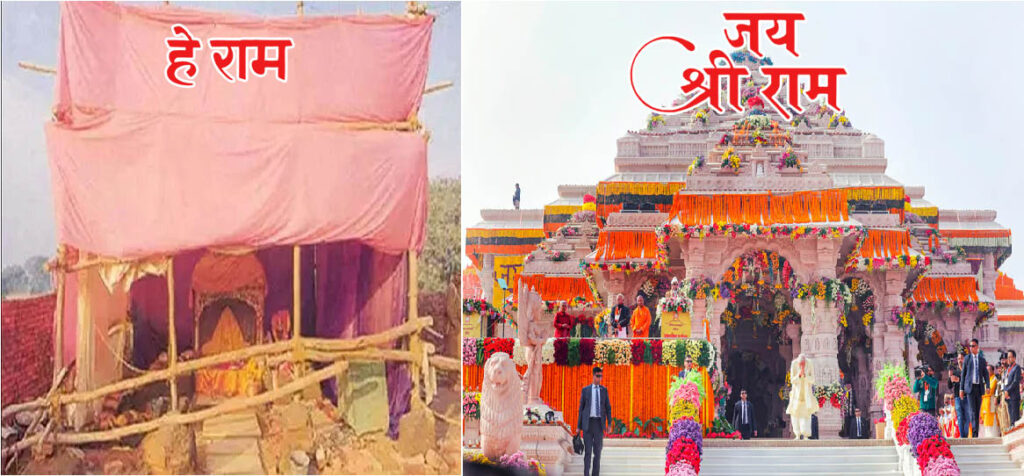
- The ‘Pran Pratistha’ of Ram Lalla in the Ayodhya Ram Mandir shows the long journey Indians have travelled to reach the path of acceptance of their historical and cultural identity.
- Successive governments have been very vulnerable to the comments and perceptions of Western media on India. Their unfair and unreasonable comparison was not effectively countered.
- Bharat is today a nation that is accepting of all cultures yet not changing its roots; a nation that is no longer embarrassed about the ideals of Shri Ram.
In 1951, when Dr. Rajendra Prasad was invited to the Somnath temple ceremony. Nehru the then Prime minister Jawaharlal Nehru went so far as to pass a cabinet resolution to desist him from attending the ceremony. Dr. Rajendra Prasad, the then president ignored all these obstructions and unapologetically attended the ceremony. During the initial days of partition, Nehru was very particular in projecting the country as a secular state in the eyes of the whole world. Nehru was so conscious of his image in the global community that he was hesitant to even touch any topic related to Hinduism.
From those days to recent times, in pursuit of a particular image of the country, India in many cases bent over backwards in its international and domestic policy matters. This is the kind of secularism that completely denies the origins and roots of the culture, the kind in which whitewashing the injustices and crimes in history became the norm in the name of maintaining social cohesion.
In contrast to this, the images of the Prime minister undergoing ‘Anustan‘ and performing the traditional rituals for the ‘Pran Pratistha‘ ceremony of Ram Mandir show the long journey Indians have travelled to reach the path of acceptance of their historical and cultural identity. Previously the most and the only popular destination in India and the whole world was limited to the Taj Mahal or Red Fort, criminally underusing the cultural and historical places and monuments or presenting and projecting them as destinations for the majority of the period after Independence. But the present dispensation realizing the potential has taken an active interest in the promotion of historical monuments from all over the nation and using every global stage to promote them. It shows that the shift in the psyche of the people has started to take place where Indians are no longer ashamed of their own ancient culture nor do they hide it as earlier.
The use of its ancient name Bharat in the international arena of the G20 summit is also one example of it. It also shows the foreign policy of Vasudev Kutumbakam in his G20 presidency tenure. The image of PM Modi greeting the delegates of different countries in front of the image of an ancient temple is also significant.
One of the other changes in foreign relations is concerning the Middle East. Despite being unapologetically true to its Hindu tradition and culture in its policy and vision, the Modi government has shown that it can have good relations with other Islamic countries. It has even managed to develop non-binary relations with Israel and other Arab nations. Relationship with Israel has taken a dramatic turn in recent years. India can augment its relationship with Israel without antagonizing the Islamic world, which wasn’t the case earlier. Before 2014, India was wary of recognizing Israel or having a full-fledged relationship with it, lest it might offend the Islamic nations.
Israel has been historically a very friendly country. It supported India even during the Kargil War by providing crucial weapons and ammunition. Yet India was previously hesitant to improve the diplomatic ties, vowing to its stance on the Palestine issue. Despite all this, India did not have full-fledged diplomatic ties with Israel until recently. Lately, it has shown that it can have cordial relationships with both Israel and Islamic nations simultaneously. The Palestine issue need not be a show-stopper to have a cordial relationship with Israel as it once thought it would be. As the External Affairs minister explains, India has been able to conceive the convergence in its international affairs.
“Hindu Pakistan!”
Previously if Bharat had gone anywhere near the path of being truthful to its identity, the whole of left-leaning media ideologically inclined to an anti-India stance would pounce on it, beating drums about it becoming ‘Hindu Pakistan’. Successive governments have been very vulnerable to these comments and perceptions of Western media. This unfair and unreasonable comparison was not effectively countered. The effect of this eternal perception trickled even to domestic policies.
Ayodhya Ram Mandir
The celebrations all around the nation for the Ram Mandir and Pran Pratista ceremony performed by the Prime Minister of India represent a decisive shift in India’s psyche. This shows that the country is ready to not only accept its ancestral heritage but celebrate it. Bharat, which is a continuation of Hindu culture with thousands of years of rich history, is finally on the path where it doesn’t have to be ashamed of its ancestral past. Bharat is today – A nation that is accepting of all cultures yet not changing its roots; A nation that is no longer embarrassed about the ideals of Shri Ram; A nation that has embraced and celebrated the ideals of Ram and Rama Rajya.
(Shreyas Goutham has an M.Sc. in Psychology and serves in NIMHANS. He writes regularly on politics, society, international affairs and technology. Opinions expressed are the author’s own)
Shreyas has an M.Sc. in Psychology and serves in NIMHANS. He writes regularly on politics, society, international affairs and technology. Views expressed are the author’s own and do not necessarily reflect the views of SamvadaWorld or its staff.
